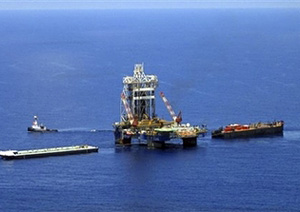 |
 |
 |
 Business News | September 2006 Business News | September 2006  
Vast Oil Pool Tapped in Gulf of Mexico
 Brad Foss - AP Brad Foss - AP


| | This June 2006 photo provided by Devon Energy Corporation shows the Jack 2 well located in the Gulf of Mexico, approximately 170 miles southwest of New Orleans in approximately 7,000 feet of water. A trio of oil companies, including Devon, has tapped a petroleum pool deep beneath the Gulf of Mexico that could boost the nation's reserves by more than 50 percent. (AP/Devon Energy Corporation) |
A trio of oil companies led by Chevron Corp. has tapped a petroleum pool deep beneath the Gulf of Mexico that could boost the nation's reserves by more than 50 percent.

A test well indicates it could be the biggest new domestic oil discovery since Alaska's Prudhoe Bay a generation ago. But the vast oil deposit roughly four miles beneath the ocean floor won't significantly reduce the country's dependence on foreign oil and it won't help lower prices at the pump anytime soon, analysts said.

"It's a nice positive, but the U.S. still has a big difference between its consumption and indigenous production," said Art Smith, chief executive of energy consultant John S. Herold. "We'll still be importing more than 50 percent of our oil needs."

Chevron on Tuesday estimated the 300-square-mile region where its test well sits could hold between 3 billion and 15 billion barrels of oil and natural gas liquids. The U.S. consumes roughly 5.7 billion barrels of crude-oil in a year.

It will take many years and tens of billions of dollars to bring the newly tapped oil to market, but the discovery carries particular importance for the industry at a time when Western oil and gas companies are finding fewer opportunities in politically unstable parts of the world, including the Middle East, Africa and Russia.

The proximity of the Gulf of Mexico to the world's largest oil consuming nation makes it especially attractive. And it could bring pressure on Florida and other states to relax limits they have placed on drilling in their offshore waters for environmental and tourism reasons.

The country's reserves currently are more than 29 billion barrels of oil equivalent, according to the U.S. Energy Department. But the U.S. imports most of its oil from abroad and its overall supply is tiny when compared with, say, Saudi Arabia, whose reserves exceed 250 billion barrels.

Chevron's well, called "Jack 2," was drilled about 5.3 miles below sea level. Chevron has a 50 percent stake in the field, while partners Statoil ASA of Norway and Devon Energy Corp. of Oklahoma City own 25 percent each.

During the test, the Jack 2 well sustained a flow rate of more than 6,000 barrels of oil per day, but analysts and executives believe the payoff could be much larger than that.

The financial implications of the prospect are most significant for independent oil and gas producer Devon, which is the smallest of the three partners. Devon's shares soared 12 percent on the New York Stock Exchange.

"This could not have happened in a better place," Devon CEO Larry Nichols said in a conference call with analysts.

The successful test well does not mean a huge supply of cheap oil will hit the market anytime soon.

Oppenheimer & Co. analyst Fadel Gheit estimated that the first production for the Chevron-led partnership might not come on line until after 2010, depending on how many more test wells the companies drill. That said, many companies, including BP PLC, Exxon Mobil Corp. and Anadarko Petroleum Corp., stand to benefit from their own projects in the so-called lower tertiary, a rock formation that is 24 million to 65 million years old.

"They may be the first ones to hit the jackpot, but if the current thinking is correct, this is only a beginning," Gheit said.

The well was drilled in the Walker Ridge area of the Gulf, about 270 miles southwest of New Orleans and 175 miles off the coast. It followed up a discovery made by Chevron in 2004.

San Ramon, Calif.-based Chevron said the well set a variety of records, including the deepest well successfully tested in the Gulf of Mexico. Chevron said the well was drilled more than 20,000 feet under the sea floor below 7,000 feet of water for a total depth of 28,175 feet.

Shares of Devon rose $7.99 to close at $72.14 on the New York Stock Exchange, above the top end of the stock's 52-week range of $48.94 to $70.35. Shares of Chevron rose $1.51, or 2.3 percent, to finish at $66.34.

On the Net: http://www.chevron.com - http://www.statoil.com - http://www.devonenergy.com | 
 | |
 |



